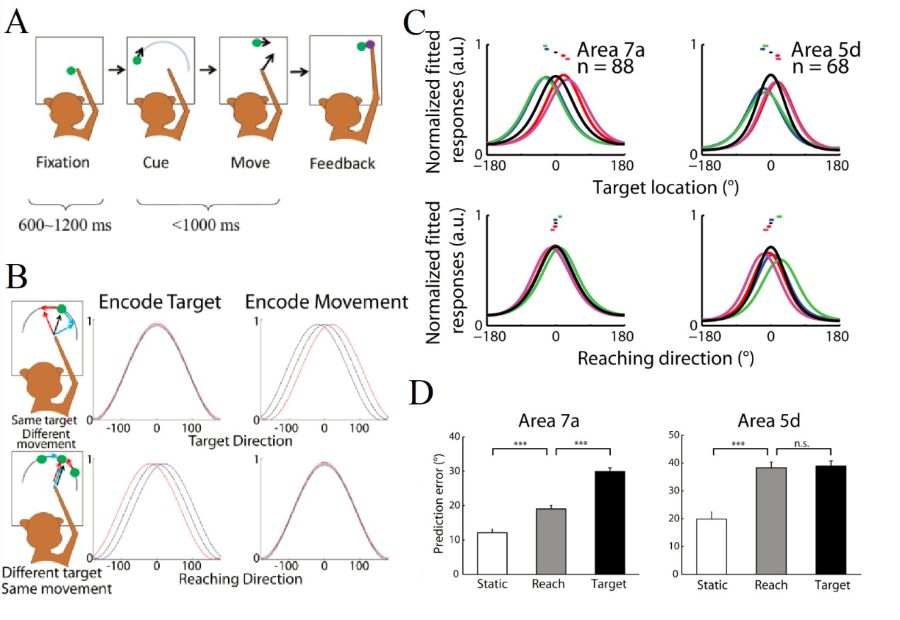Time:2022-03-21
A recent study published in Proceedings of the National Academy of Sciences demonstrated that a brain region in the posterior parietal cortex (PPC) predicts upcoming movements in dynamic sensorimotor control. This work was led by Dr. CUI He at the Institute of Neuroscience, Center for Excellence in Brain Science and Intelligence Technology of the Chinese Academy of Sciences. This work has successfully established a novel behavioral paradigm which is capable of decouple the neural encoding of movement from the encoding of the sensory cue that led to the movement. The result will inspire further studies to discriminate the encoding of different highly correlated yet distinct task/behavioral parameters in sensorimotor control.
Although it is generally believed that PPC plays an important role in motor plan, spatial perception, and attention, it is controversy whether the PPC predominately integrates sensory information for elaborating appropriate movements,{Andersen, 2009 #2} or plays a proactive role in motor preparation. Given the PPC’s critical role in sensorimotor control and the recent development brain machine interface based on PPC implanting, it is crucial to understand the neural encoding of PPC in sensorimotor behaviors.
Previous studies on spatial sensorimotor control in PPC predominately used static sensory target as the movement goal, leading to tight coupling between the sensory target location and subsequent movement, making it difficult to explain whether the neural signals encode the sensory or the movement information. Disentangling these neural codes requires a behavioral paradigm to decouple the sensory target location and the movement direction.
In the present study, Cui lab designed a flexible manual interception task in which the macaque monkeys were trained to intercept a moving target (Figure A). In the task the target could move in a variety of directions or speeds, the targets in the same instantaneous location could lead to hand movement to different directions, while hand movement to the same direction could be elicited by targets in different instantaneous locations (as illustrated by the upper left and bottom left panels in Figure B, respectively). As a result, it is possible to determine whether a neuron encodes the instantaneous target location or upcoming movement direction by examining whether the neuron’s tunings to target locations or movement directions vary with different target moving speeds. If a neuron’s directional tuning to target location is invariant at different target moving speeds, yet its tuning to hand movement direction changes with different target speeds, the neuron encodes target location (middle plots in Figure B); on the contrary, if a neuron’s tuning to hand movement is independent of target speeds but its tuning to target location is not, then the neuron encodes hand movement direction (right plots in Figure C).
Li et al. recorded the single-unit activities from area 7a and area 5d in PPC in two rhesus monkeys while they were performing the flexible manual interception task. To characterize the neuronal selectivity to target location or movement direction at single-cell level, the researchers fitted the directional tuning curve with a circular Gaussian (von Mises) function to get the preferred direction of the tuning curves, then computed the variance the preferred directions across different target speed conditions. To study the neural coding at the population level, the researchers adopted the method of support vector regression, by training the model using the firing rates recorded when the animals were reaching to static targets, and then applied the trained model to decode the directions from population activity during interception, to compare the decoded directions to the actual instantaneous target locations or hand movement directions.
It was found that in area 7a the target-location tuning curves shifted with the target motion speeds, while hand-movement tuning curves were invariant (left plots in Figure C). In area 5d, the both the target-location and the movement tuning curves varied with target motion speed. At the population level, in area 7a the prediction error between the direction decoded from neural activities during interception and the actual hand movement direction is significantly smaller than the prediction error between the decoded direction and the target direction (left in Figure D), while in area 5d these two types of errors had no significant difference (right in Figure D). These results indicates that area 7a encodes upcoming hand movement directions rather than instantaneous target location, implying a proactive role of PPC in motor preparation.
This project successfully established a behavioral paradigm that could be used to dissociate the neural decoding to sensory information from that to movement information, and demonstrated the separation of neural encoding of these two highly correlated information. This project will foster further dissection of different sensory or movement-related neural codes across brain regions involved in the dynamic sensorimotor control.
This study entitled “Posterior parietal cortex predicts upcoming movement in dynamic sensorimotor control” was published online in PNAS on March 22, 2022. LI Yuhui and WANG Yong are the first and second authors, respectively. This work was supported by the Ministry of Science and Technology of the People′s Republic of China, National Natural Science Foundation of China, Chinese Academy of Sciences, Shanghai Municipal Government, Whitehall Foundation, and Alfred P. Sloan Research Fellowship.

Figure legend: (A) The flexible manual interception task. (B) Theoretical prediction of two different encodings. (C) Result of preferred direction variance across different target speed conditions (D) Results of population decoding.(Image by EBSIT)
Keywords: Sensorimotor control, Macaque monkeys, Reaching, Manual interception, Single-unit activity.
AUTHOR CONTACT:
CUI He
Center for Excellence in Brain Science and Intelligence Technology, Chinese Academy of Sciences, Shanghai, China.
Phone: 86.21.5492.1806; E-mail: hcui@ion.ac.cn
 附件下载:
附件下载: